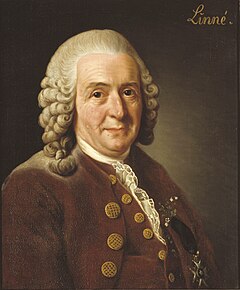 |
| Carl Linnaeus |
Every living thing on this planet is related to every other living thing on this planet. Carl Linnaeus was a Swede born in 1707 and he was, a Botanist, Physician and a Zoologist. Linnaeus was known as the father of modern Taxonomy. We still use Linnaeus Morphology based idea. At the end of his lifetime the Linnean collection in Uppsala was considered as one of the finest collections of natural history. Domains are Bacteria, Archaea and Eukarya. The Bacteria and the Archaea are Prokaryotes. Eukarya makes all the lifeforms with the Nucleus. Archaea is closely related to Eukarya. Animals are multicellular. Rothman showed Linnaeus that botany was a serious subject. The local doctor Kilian Stobaeus offered Linnaeus tutoring and lodging, as well as the use of his library, which included many books about botany. Linnaeus entered the Vaxjo Gymnasium in 1724, where he studied mainly Greek, Hebrew, theology and math course designed for boys preparing for the priesthood. In the last year at the gymnasium, Linnaeus's father visited to ask the professors how his son's studies were progressing. The Trick of Taxonomy is basically figuring out where all of those branches of the evolutionary tree are. Taxonomy isn't about describing life and all of its ridiculous detail, it's about helping humans understand it because it's way to complicated without structure. There are 2,000,000 organism maybe 5,000,000 to 100,000,000. The natural world is one huge grey area. Back then, people grouped organisms by analogous or homoplasmic traits. Structures that appear similar but actually come from completely independent origins. An example of a modern classification is the one published in 2009 by the Angiosperm Phylogeny Group for all living flowering plant families. Biological classification is a critical step in the taxonomic process. In numerical taxonomy, the taxonomy is exclusively based on cluster analysis and neighbor joining. New species keep on being discovered all the time. Taxonomies of the more generic kinds of things typically stem from philosophical investigations. 1. The taxon must be given a name based on the 26 letters in the Latin alphabet. 2.The name must be unique. 3. The description must be based on at least one name-column type specimen. 4. It should include reference to the attributes that make the taxon unique. 5. These first four requirements must be published in a work that is obtainable in numerous identical copies, as a permanent scientific record. However, often much more information is included, like the geographic range of the taxon, ecological notes, chemistry, behavior. Historical records show that informally classifying organisms took place at least back to the days of Aristotle. Even taxonomic names published by Linnaeus himself before these dates are considered pre-Linnaean. Taxonomy is mostly about animals. If you go far enough back we all have a common ancestor an organism both you and I are descendant from, or maybe a Starfish or a Blue whale are descendant from. Linnaeus was born from a Peasant family. Bacteria lives everywhere on Earth like inside of you and deep in the Earth's crust. Archaea has a different cell membrane and the Enzymes they use to make RNA, RNA Polymerase is much more like ours. Taxonomy is life's filing system. Plantae contain autotrophs Fungi and animalia contain heterotrophs protista is weird because it contains autotrophs and heterotrophs. Animals are multi-cellular. Cats are in the family carnivora. Taxonomy is a sub-discipline of biology, and is generally practiced by scientists known as "taxonomists", though enthusiastic naturalists are also frequently involved in the publication of new taxa. Taxonomy, or categorization, in the human cognition has been a major area of research in psychology. Back then surnames were just for rich people so Carl just made one up Linnaeus after the Lindon trees that grew on is families homestead. Carl Linnaeus categorized 7,700 plants and 4,400 animals.


No comments:
Post a Comment